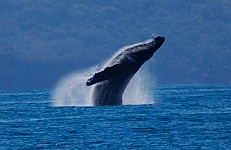
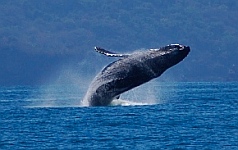

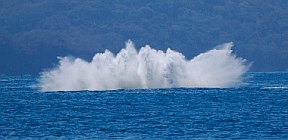

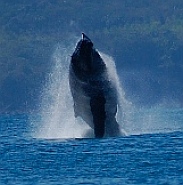
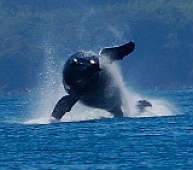
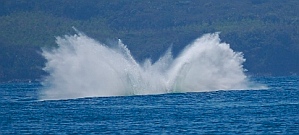

The ruined church on the hill that held
Longfellow's Bells of San Blas.
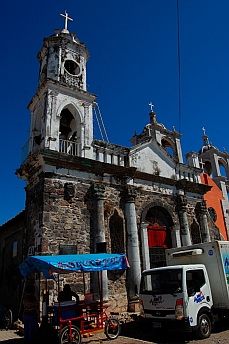
The "new" church that replaced the
church on the hill.


This newest church that replaced the "new" church
next door.

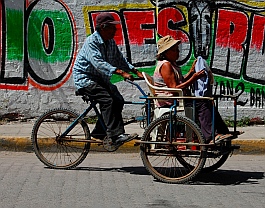
Every wife deserves a ride like this from
her hubby.
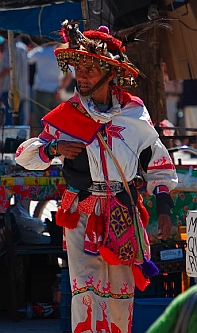
It was a crazy busy day in the
town square and we saw all
kinds of folks...
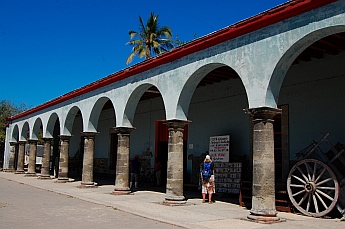

A mural depicts the town of San Blas.
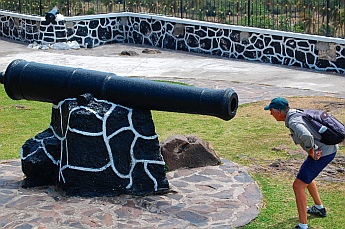
The guys liked the cannons at the fort.

The Belle of the Ball preps for her
15th birthday.
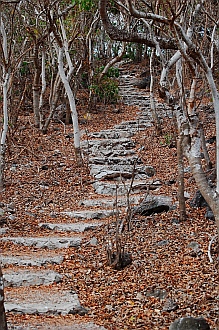
A path over a ridge on Isla Isabel
led to a frigate bird rookery.
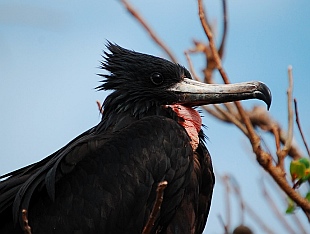
A frigate bird keeps an eye on me, his red pouch
deflated.
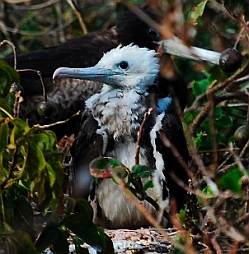
A frigate bird chick huddles on its nest.

Two frigate bird eggs resemble
chicken eggs.

A pale headed & dark faced
brown booby on a cliff.
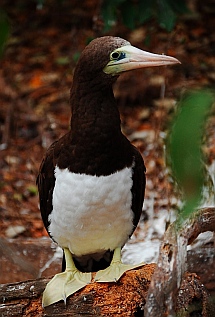
A dark headed brown booby
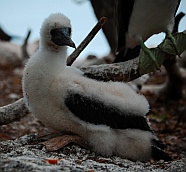
Booby chicks.
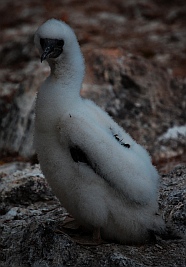
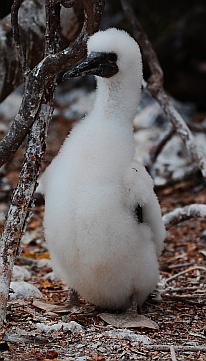

A blue footed booby!
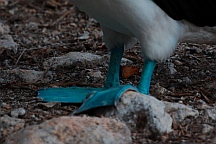
Yep, those are blue feet.

The blue footed booby blocks the path
and tells me to go home.

A colorful snake winds around a
tree trunk.
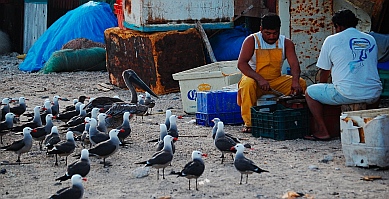
The flock waits for handouts from the fishermen.

How we look after an overnight passage.
San Blas & Isla Isabel, Mexico
Early April, 2011 - We left the crowd of cruisers in La Cruz and eagerly looked forward to more quiet anchorages on our way
north to Mazatlán. The winds were in our favor and we had two glorious days of sailing, stopping for an overnight at Isla Peña.
The second morning was sunny and warm with a light breeze, and the boat danced easily on its course. We were both
somewhere out there in daydream land when suddenly we heard an enormous splash. Leaping to our feet we watched a
humpback whale shoot straight up out of the water, turn, and fall crashing back down on its side.
When a much smaller whale tail flapped nearby, we realized this was a mother
with a baby. A few moments later the whale surged out of the sea again, this
time doing a full twist before falling back into the depths. A little ways away the
smaller tail waved again.
Our second night we stopped at Ensenada
Mantachén, a large bay that looked at first like an
ideal spot to spend a few days.
It is a short
bus ride from
the little community of Mantachén into the town
of San Blas, which is famous for inspiring
Longfellow's poem The Bells of San Blas.
Reading that wistful poem made us curious
about the ruined church on the hill whose once
clanging bells are now muted and "green with
mould and rust." At one time they symbolized a
dark era of conquest, when Spain ruled and "the
world with faith was filled." But now the bells
stand silent, reminding us of "an age that is
fading fast" while "the world rolls into light."
We walked through the ruins of the church on
the hill, and then explored the ruins of the "new"
church down in the town. The new church has
been replaced by another even newer church
next door. This newest church is where today's
faithful go to worship.
San Blas was very busy on the day of our visit.
Citizens, government officials and armed
soldiers filled the town square. I asked several
people what was going on but didn't fully understand the
explanations. I think it was some kind of survey of the local people to
determine their standard of living. As tourists, we simply enjoyed
watching the scene.
Up on the hill by the old church
stands an old fort that we explored
with friends. The cannons were fun
for the guys. More fun for us gals
was seeing a young girl getting
photos taken for her "quinceañera,"
or 15th birthday. This is a very
important milestone birthday for
Mexican girls, a kind of "coming
out," and it is celebrated with a
huge party and a fantastic prom
dress.
Many small towns exude charm and make visitors feel welcome and
safe, but San Blas is not that way. As one fellow cruiser put it, "I wouldn't go out after dark
here." At the beach palapa restaurant in Mantachén the owner even wore a sidearm. We
had been put on guard immediately upon arrival at the Matanchén anchorage when a group
of cruisers pulled alongside our boat in their dinghy and said, "Make sure you lock your
outboard at night. There have been some outboard and dinghy thefts in the last few
weeks." We put cable locks on everything on deck but slept fitfully. Mark bolted out of bed
at 2:30 a.m. when he heard people on a panga nearby tapping on the panga's hull. They
appeared to be fishing, so he went back to sleep. Next morning our friends discovered their
Mercury 9.9 hp outboard had been stolen. They had raised their dinghy in its davits so it
was 6 feet off the water, but they hadn't locked the outboard. It seemed to us that this theft
had been carefully orchestrated and must have involved more than one person.
We had planned the next day to go on an estuary tour that many other visitors to the area
have raved about, but we had a sour taste in our mouths after that episode and we left right
away.
Isla Isabel waited peacefully on the horizon for us, just 50 or so miles away to the north. No
sooner had we dropped the hook than the couple on the neighboring sailboat swung by and
invited us to go ashore with them. Stepping out of the dink onto the beach we found
ourselves in the middle of a fish camp. A row of pangas sat on the beach in front of a row
of shacks, and piles of fishing nets filled the space in between.
A friendly fisherman guided us to a
path that goes to the interior of the
island, and after climbing up and
over a ridge we found ourselves in
the heart of a frigate bird rookery.
A canopy of short trees formed a
roof above us, and on every
branch a frigate bird hunched over
an impossibly rickety little nest.
The chicks were nearly full-sized,
but their feathers weren't fully
grown in yet, and they had that
goofy look of pre-adolescents
everywhere.
The ground was thick with guano, and we danced around
looking up at the undersides of the birds while ducking in fear
that we might become targets for droppings. I found the
remains of a few chicks that must have fallen out of their nests
a while ago, and we found two unhatched eggs. They were
the size of chicken eggs, but they were heavy. No doubt each
one held a well formed chick that didn't make it out in time.
We followed the path up another hill and emerged onto the
cliffs that line the edge of the island. In front of us, blocking the
way, were legions of boobies. They stared at us with quiet
curiosity, watching our every move, but showed no particular
signs of fear or of getting out of the way.
We had seen our first boobies several months earlier when
we sailed into Manzanillo Bay. It had been late afternoon and
lines of them were commuting back home to roost. We
weren't sure what kind of bird they were, but we started
calling them "tuxedo birds" because of the way they dressed.
Seeing them so close
now I realized there are
several variations. Some
have light colored heads
with a dark face and
some have dark colored
heads with a light face.
But all the chicks were
fluffy and cute.
We pressed on through
the crowd along the edge
of the cliff, and each
parent/chick pair backed away a little as we went by. Then
we turned a corner, and faced an unusually obstinate
booby. This one had blue feet!
Apparently the
Galápagos islands are
not the only habitat in
the world where blue
footed boobies live, and this little mom was doing her
darndest to make sure her species thrived here on Isla
Isabel.
She stood her ground as we
approached, effectively blocking her
chick and the path with a very
impressive display. She fluffed up her
feathers, made all kinds of noises and
generally told us to back off.
A few quick photos and we did as we were told, tromping back down the hill into the frigate
bird colony and back to the beach.
Mark is a woodsman at heart, and he spotted an unusual snake in a tree. We tried to
remember the rhyme about the color patterns on coral colored snakes, "Red touch yellow,
kill a fellow," or something like that, but we couldn't quite remember how it went. We later
found the coral snake rhyme online and discovered our little guy was a milk snake.
After all this exotica it
seemed rather pedestrian to
watch the congregation of
seagulls and pelicans lining
up for scraps from the
fishermen. But I still love
these guys too. These gulls
make a cry that sounds like,
"Ow ow ow," as if someone
is pinching them mercilessly.
While at San Blas we visited the cultural center which has a gallery with
a handful of paintings in it. One in particular caught my eye because it
shows the exact expression we have on our faces whenever we do an
overnight passage on the boat. The trip from Isla Isabel to Mazatlan is
90 miles, just long enough to require an overnight. Fortunately we were
able to sail almost the entire way rather than run the engine. However,
the wind was right on the nose, so we had to tack back and forth in a
zig-zag pattern for 20 hours. The wind also changed strength every
hour, which required us to reef and unreef the sails repeatedly so the
boat could take advantage of the wind rather than the other way around.
By the end of the night we actually looked a bit worse than the guy in
this painting.
Find San Blas and Isla Isabel on Mexico Maps

